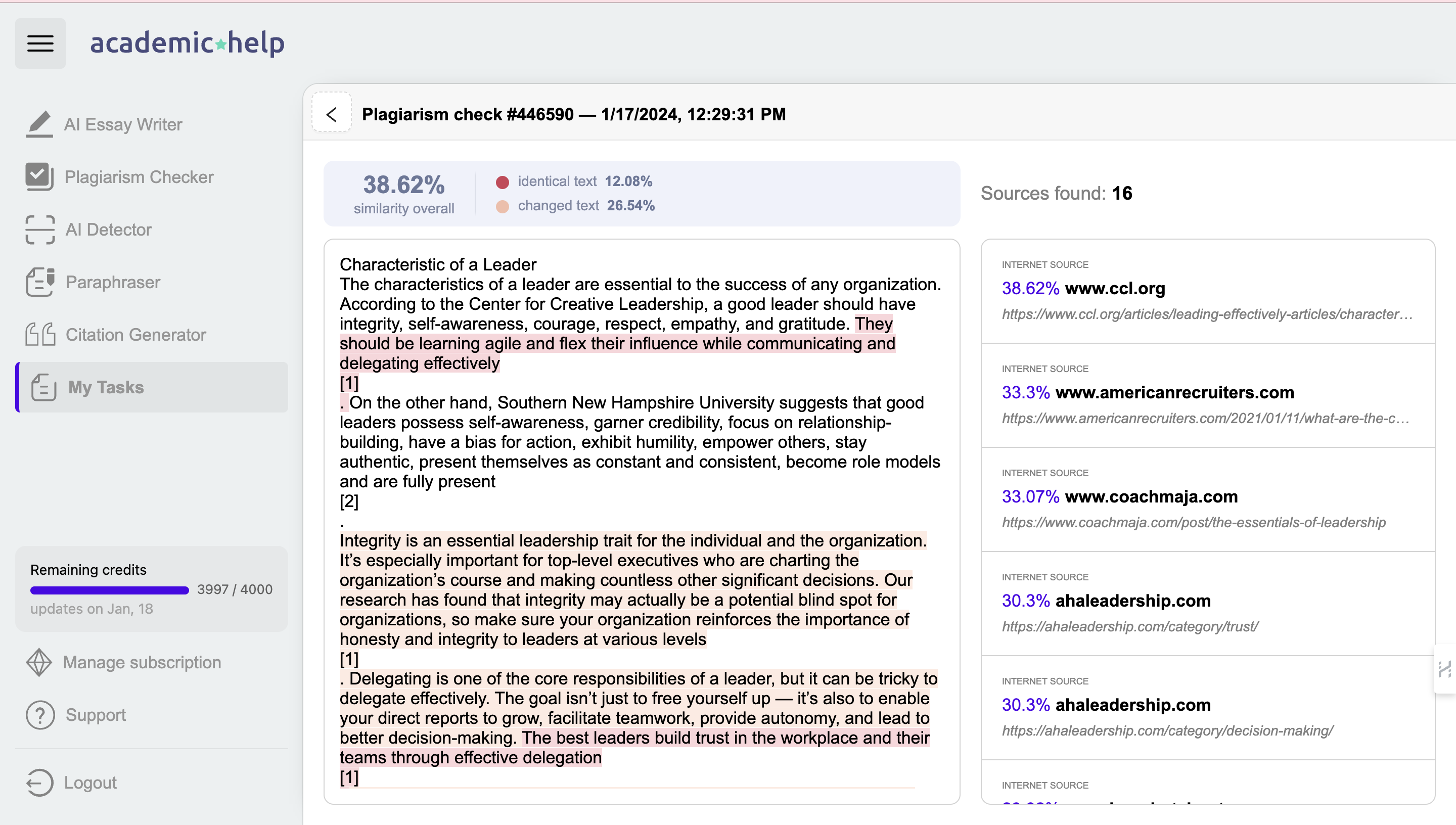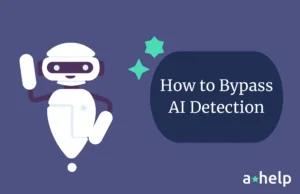The rise of AI-generated content has definitely changed the way we create and consume information. ChatGPT, a powerful language model, has become a popular tool for students and professionals alike, because it offers a quick and coherent responses to a wide range of questions, from “Give me a mocktail recipe” to “Solve the following integral”. However, this convenience comes with a challenge: the potential for plagiarism.

✅ AI Essay Writer ✅ AI Detector ✅ Plagchecker ✅ Paraphraser
✅ Summarizer ✅ Citation Generator
How Does Chat GPT Generate Content?
ChatGPT, an advanced language model, creates content through a certain process that involves the analysis of lots of textual information. By sifting through this data, the model identifies and internalizes patterns in language usage, syntax, and semantics, which as a result make up the text and the tone of voice. This learning enables ChatGPT to understand the context and nuances of various topics.

When a user inputs a query or topic, ChatGPT retrieves relevant information from its knowledge base it has been trained on. It then applies its understanding of language patterns to construct responses that are both coherent and appropriate in a certain context. This ability to generate human-like text is a result of the model’s deep learning algorithms, which allow it to predict the most likely sequence of words in a response.
However, the reliance on pre-existing content as a foundation for generating responses introduces the potential for plagiarism. Since ChatGPT’s responses are formulated based on the information it has learned from its training data, there is a risk that the generated content may closely mirror the original sources (and sometimes it is a straight ripoff). When writing articles and blog posts, people wonder “Can Google detect AI?” This risk is very high when the model encounters common phrases or sentences that come up often in its training data. As a result, users of ChatGPT-generated content must be attentive and check for plagiarism to keep the originality and integrity of their work.
Why is it Important to Check for Plagiarism in ChatGPT?
Checking for plagiarism in ChatGPT-generated content is crucial due to the model’s reliance on pre-existing data for response construction.
In academic settings, originality is a cornerstone of scholarly work, reflecting a student’s mastery and individual thought process. Therefore, plagiarism, intentional or accidental, can tarnish a student’s reputation, resulting in disciplinary actions.
In professional contexts, the stakes are equally high. Plagiarism can damage a professional’s credibility and integrity, leading to potential legal ramifications and loss of trust among colleagues and clients. Moreover, in industries where innovation and creativity are valued, original content is a measure of competence and competitiveness.
For ChatGPT users, the risk of plagiarism is heightened due to the model’s method of generating responses based on its training dataset. While ChatGPT can produce relevant and coherent text, it may replicate phrases or sentences from its source material. Therefore, it is vital to manually edit ChatGPT-generated content for originality so that it adds value, follows ethical standards, and upholds the principles of academic and professional integrity.
What Are the Consequences of ChatGPT Plagiarism?
The consequences of ChatGPT plagiarism go beyond immediate penalties and can have long-term implications.
In academia, a student caught plagiarizing a major assignment might receive a zero grade, leading to a significant drop in their overall GPA. In severe cases, repeated offenses could lead to expulsion, permanently affecting the student’s academic and professional future.
As to the professional world, a journalist, for example, found plagiarizing content could face termination of employment, a damaged reputation, and difficulties finding future work in the field. In industries where intellectual property is crucial, such as research and development, legal consequences might include lawsuits, financial penalties, and loss of patents.
Moreover, the overreliance on AI-generated content like ChatGPT can also negatively influence the development of critical thinking and problem-solving skills, as individuals might become dependent on AI for generating ideas and content. This dependency can lead to a lack of innovation and a decrease in the quality of work produced, as the unique perspectives and insights that come from human thought are replaced by AI-generated content.
So, How to Check for Chat GPT Plagiarism in AI Generated Content?
To effectively check for ChatGPT plagiarism in AI-generated content, several strategies can be employed, each with its distinct approach:
- Online Plagiarism Checkers
These tools are widely used to assess the originality of content. They work by scanning the submitted text against a comprehensive database of existing sources, including academic papers, articles, and websites. When a match is found, an AI detector checker highlights the sections and provides a percentage score indicating the extent of similarity. This score helps gauge the severity of the plagiarism issue. Popular examples of such checkers include Turnitin, Grammarly, and Copyscape. These platforms are user-friendly and offer quick results, making them a convenient option for both students and professionals.
- Comparison with Original Sources
This method involves a more hands-on approach, where the AI-generated content is manually compared to the original materials it may have drawn from. This requires having access to the source material and thoroughly analyzing the text to spot any direct copying or paraphrasing. This approach, though, can be time-consuming. Still, it is quite effective in identifying specific instances of plagiarism that automated tools might miss. It’s particularly useful when the suspected source material is not included in the databases of online plagiarism checkers. - AI Detection Software
As AI-generated content becomes more prevalent, specialized software tools have been developed to specifically identify content produced by AI models like ChatGPT. These tools analyze the writing patterns, syntax, and other linguistic features characteristic of machine-generated text, distinguishing them from human-written content. By identifying these patterns, the software can flag content that is likely AI-generated, which can then be further examined for plagiarism. This method is particularly useful for detecting more subtle forms of AI plagiarism that may not be apparent through traditional plagiarism checkers.
Each of these methods has its strengths and limitations, and often, a combination of approaches is most effective in accurately identifying ChatGPT plagiarism.
Signs of Plagiarism in Chat GPT-Generated Content
If you decide to opt for a manual check of your work, note that identifying plagiarism in ChatGPT-generated content requires careful examination of the text for specific tell-tale signs:
- Unusual Phrasing
ChatGPT-generated content may include phrases or sentences that appear overly sophisticated or out of context.
For example, a simple topic might be described using unnecessarily complex language, such as using “utilize” instead of “use” in a basic sentence like “You should utilize a pencil.” - Inconsistencies in Style
A sudden shift in writing style or tone within the same piece of content could be a red flag.
For instance, a paragraph that begins in a formal academic tone like this
“In recent decades, the phenomenon of global warming has escalated, leading to unprecedented changes in the Earth’s climate systems. The increase in greenhouse gas emissions, primarily carbon dioxide and methane, has been identified as a significant contributor to this trend.”
might abruptly switch to a conversational style, like this
“Did you know that cars and factories are spewing out loads of CO2? As we look at this problem now, it is clear that we need to do something about it, or we’re all going to end up in hot water.”
This change indicates potential plagiarism from different sources. - Lack of Originality
Content that seems generic or lacks personal insight might suggest reliance on AI-generated responses.
For example, an essay that merely summarizes a topic without adding any new analysis or perspective could be indicative of AI-generated content. - Exact Matches
Finding sentences or phrases that match verbatim with existing texts is a strong indication of plagiarism.
For example, if even one sentence in a student’s essay is identical to a line from a published article, you will likely find more plagiarized content when reading further.
By being aware of these signs, students, writers, and many others who use AI, can more effectively spot potential plagiarism in ChatGPT-generated content and take appropriate action.
Conclusion
As AI technology continues to evolve, the challenge of Chat GPT plagiarism is almost impossible to brush aside. It’s necessary for students and professionals to be motivated and proactive in making sure their work is original. We advise you to dive deeper into the mechanisms behind AI-generated content, to try out several detection methods, and to be mindful of the signs of plagiarism. This way, it will be much easier to maintain the integrity of your work and uphold academic and professional standards.
You should also consider using AHelp AI checker to revise your academic papers and boost the quality of your writing.
FAQ
Follow us on Reddit for more insights and updates.





Comments (0)
Welcome to A*Help comments!
We’re all about debate and discussion at A*Help.
We value the diverse opinions of users, so you may find points of view that you don’t agree with. And that’s cool. However, there are certain things we’re not OK with: attempts to manipulate our data in any way, for example, or the posting of discriminative, offensive, hateful, or disparaging material.